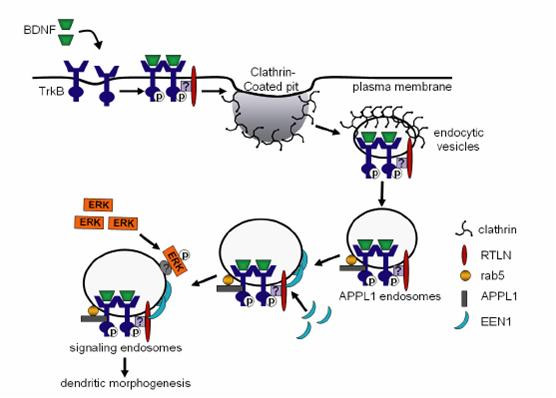-
Scientists Discover a Novel Mechanism for BDNF-TrkB to Regulate Signaling
TIME: 05 Sep 2011Brain-derived neurotrophic factor (BDNF), a member of the neurotrophin family of target-derived growth factors, binds to its cell surface receptor TrkB to regulate differentiation, development, synaptic plasticity and functional maintenance of neuronal cells. Binding of BDNF triggers TrkB dimerization and autophosphorylation, which provides docking sites for adaptor proteins to recruit and activate downstream signaling molecules. The molecular mechanisms underlying BDNF-TrkB endocytic trafficking crucial for spatiotemporal control of signaling pathways remain to be elucidated.
A research group led by Dr. Jia-Jia Liu at the Institute of Genetics and Developmental Biology, Chinese Academy of Sciences found that retrolinkin, a transmembrane protein, previously found to play a role in retrograde axonal transport in sensory neurons, also functions in BDNF-TrkB trafficking and signaling in CNS neurons. Retrolinkin directly interacts with endophilin A1 and both proteins are required for BDNF-TrkB early endocytic trafficking and spatiotemporal regulation of BDNF-induced ERK activation. Retrolinkin not only functions in endocytosis of BDNF-TrkB, but also recruits endophilin A1 to pTrk, APPL1-positive endosomes to regulate acute activation of ERK on early endosomes. Suppression of retrolinkin expression not only blocks BDNF-triggered TrkB internalization, but also prevents recruitment of endophilin A1 to pTrk vesicles trafficking through APPL1-positive endosomes. These findings reveal a novel mechanism for BDNF-TrkB to regulate signaling both in time and space through a specific membrane trafficking pathway. In addition, this research is the first to demonstrate that endophilin A1, previously known to play a role in synaptic vesicle recycling and synaptic transmission at the presynaptic site, also functions in post-endocytic trafficking and signaling of BDNF and regulates dendritic morphogenesis.
The related paper was published online on Molecular Biology of the Cell (DOI: 10.1091/mbc.E11-04-0308, http://www.molbiolcell.org/cgi/content/abstract/mbc.E11-04-0308v1). This research was supported by grants from the National Natural Science Foundation of China, Ministry of Science and Technology and CAS Key Project.

(Image by FU Xiuping etc.)Figure. Working model for a role of retrolinkin and endophilin A1 in BDNF-TrkB endocytic trafficking and downstream signaling pathways. TrkB receptors are activated upon binding to BDNF, and the internalization of BDNF-TrkB complex into endocytic vesicles is mediated by retrolinkin through unknown mechanisms. After TrkB-positive endocytic vesicles mature into APPL1 endosomes, endophilin A1 is recruited to these endosomes by retrolinkin and then downstream effectors such as ERK1/2 are recruited to signaling endosomes for acute activation. RTLN, retrolinkin; EEN1, endophilin A1.
AUTHOR CONTACT:
LIU Jiajia, Ph.D.
Institute of Genetics and Developmetnal Biology, Chinese Academy of Sciences, Beijing, China.
E-mail: jjliu@genetics.ac.cn
 CAS
CAS
 中文
中文




